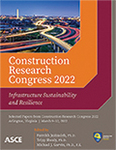Impacts of the COVID-19 Pandemic on Services Utilization and Energy Consumption in Healthcare Facilities: Evidence from Shanghai Municipal Hospitals
Publication: Construction Research Congress 2022
ABSTRACT
Starting from December 2019, the novel coronavirus disease 2019 (COVID-19) has been rapidly spreading throughout the world, disrupting individuals’ lives and the function of the whole human society. At the frontlines of the fight against the COVID-19 pandemic, multiple aspects of healthcare facilities have been significantly affected. To fill the information gap in the scientific literature, a small pilot study was conducted in this paper to assess the impacts of COVID-19 on service utilization and energy consumption in healthcare facilities. Monthly services utilization data including number of outpatients and emergency patients (NOEP), number of inpatients (NIP), and monthly total energy consumption (TEC) data of five Shanghai large-scale municipal hospitals have been utilized. The impacts were modeled using the autoregressive integrated moving average (ARIMA) model with the normal period (January 2015–December 2019) and compared with COVID-19 period (January 2020–December 2020). The empirical results show that the impacts of COVID-19 on services utilization were significantly greater than those on energy consumption. In addition, the magnitude of the impact has varied significantly according to the type of service and healthcare facilities. This study provides insights for healthcare facilities in assessing services utilization and energy demand during times of public health crises, such as the COVID-19 pandemic.
Get full access to this article
View all available purchase options and get full access to this chapter.
REFERENCES
Bahmanyar, A., Estebsari, A., and Ernst, D. (2020). “The impact of different COVID-19 containment measures on electricity consumption in Europe.” Energy Research and Social Science, Elsevier, 68(July).101683. https://10.1016/j.erss.2020.101683.
Challa, M. L., Malepati, V., and Kolusu, S. N. R. (2018). “Forecasting risk using auto regressive integrated moving average approach: an evidence from S&P BSE Sensex.” Financial Innovation, 4(1). https://10.1186/s40854-018-0107-z.
Chan, Y. H. (2003). “Biostatistics 104: correlational analysis.” Singapore medical journal, 44(12).614–9.
Dritsaki, C., Niklis, D., and Stamatiou, P. (2021). “Oil consumption forecasting using ARIMA models: an empirical study for Greece.” International Journal of Energy Economics and Policy, 11(4).214–224. https://10.32479/ijeep.11231.
He, H., and Harris, L. (2020). “The impact of Covid-19 pandemic on corporate social responsibility and marketing philosophy.” Journal of Business Research, Elsevier, 116(May).176–182. https://10.1016/j.jbusres.2020.05.030.
IEA. (2020). Global Energy Review 2020 – Analysis. IEA.
Jia, Z., Wen, S., and Lin, B. (2021). “The Effects and Reacts of COVID-19 Pandemic and International Oil Price on Energy, Economy, and Environment in China.” Applied Energy, Elsevier Ltd, 302(March).117612. https://10.1016/j.apenergy.2021.117612.
Kaye, A. D., Okeagu, C. N., Pham, A. D., Silva, R. A., Hurley, J. J., Arron, B. L., Sarfraz, N., Lee, H. N., Ghali, G. E., Gamble, J. W., Liu, H., Urman, R. D., and Cornett, E. M. (2020). “Economic impact of COVID-19 pandemic on healthcare facilities and systems: International perspectives.” Best Practice & Research Clinical Anaesthesiology, (January). https://10.1016/j.bpa.2020.11.009.
Kim, H. W., Lee, J. H., Choi, Y. H., Chung, Y. U., and Lee, H. (2011). “Dynamic bandwidth provisioning using ARIMA-based traffic forecasting for Mobile WiMAX.” Computer Communications, 34(1).99–106. https://10.1016/j.comcom.2010.08.008.
Lai, S. L., Liu, M., Kuo, K. C., and Chang, R. (2014). “Energy Consumption Forecasting in Hong Kong Using ARIMA and Artificial Neural Networks Models.” Applied Mechanics and Materials, 672–674.2085–2097. https://10.4028/www.scientific.net/AMM.672-674.2085.
Mitchell, W. B. (2020). “Thromboinflammation in COVID-19 acute lung injury.” Paediatric Respiratory Reviews, Elsevier Ltd, 35.20–24. https://10.1016/j.prrv.2020.06.004.
Mokhtari, R., and Jahangir, M. H. (2021). “The effect of occupant distribution on energy consumption and COVID-19 infection in buildings: A case study of university building.” Building and Environment, Elsevier Ltd, 190(October 2020).107561. https://10.1016/j.buildenv.2020.107561.
Ozturk, S., and Ozturk, F. (2018). “Forecasting Energy Consumption of Turkey by Arima Model.” Journal of Asian Scientific Research, 8(2).52–60. https://10.18488/journal.2.2018.82.52.60.
Şahin, U., Ballı, S., and Chen, Y. (2021). “Forecasting seasonal electricity generation in European countries under Covid-19-induced lockdown using fractional grey prediction models and machine learning methods.” Applied Energy, 302(March).117540. https://10.1016/j.apenergy.2021.117540.
Suhlrie, L., Bartram, J., Burns, J., Joca, L., Tomaro, J., and Rehfuess, E. (2018). “The role of energy in health facilities: A conceptual framework and complementary data assessment in Malawi.” PLoS ONE, 13(7).1–19. https://10.1371/journal.pone.0200261.
WHO. (2021). “WHO Coronavirus (COVID-19) Dashboard | WHO Coronavirus (COVID-19) Dashboard With Vaccination Data.” <https://covid19.who.int/>(Aug. 31, 2021).
Wsjkw. (2021). “Shanghai Municipal Health Commission 上海市卫生健康委员会.” <http://wsjkw.sh.gov.cn/>(May 22, 2021).
Xiao, H., Dai, X., Wagenaar, B. H., Liu, F., Augusto, O., Guo, Y., and Unger, J. M. (2021). “The impact of the COVID-19 pandemic on health services utilization in China: Time-series analyses for 2016–2020.” The Lancet Regional Health - Western Pacific, Elsevier Ltd, 9(March).100122. https://10.1016/j.lanwpc.2021.100122.
Yuan, C., Liu, S., and Fang, Z. (2016). “Comparison of China’s primary energy consumption forecasting by using ARIMA (the autoregressive integrated moving average) model and GM(1,1) model.” Energy, Elsevier Ltd, 100.384–390. https://10.1016/j.energy.2016.02.001.
Information & Authors
Information
Published In
History
Published online: Mar 7, 2022
Authors
Metrics & Citations
Metrics
Citations
Download citation
If you have the appropriate software installed, you can download article citation data to the citation manager of your choice. Simply select your manager software from the list below and click Download.
